CQUniversity Auditing and Ethics Report: ACCT20075 Analysis
VerifiedAdded on 2023/03/17
|15
|2925
|85
Report
AI Summary
This report presents an analysis of an auditing assignment for ACCT20075, focusing on the financial statements of Investa Office Fund. The report begins with an introduction to auditing and then delves into the calculation and analysis of planning materiality, crucial for identifying material errors an...
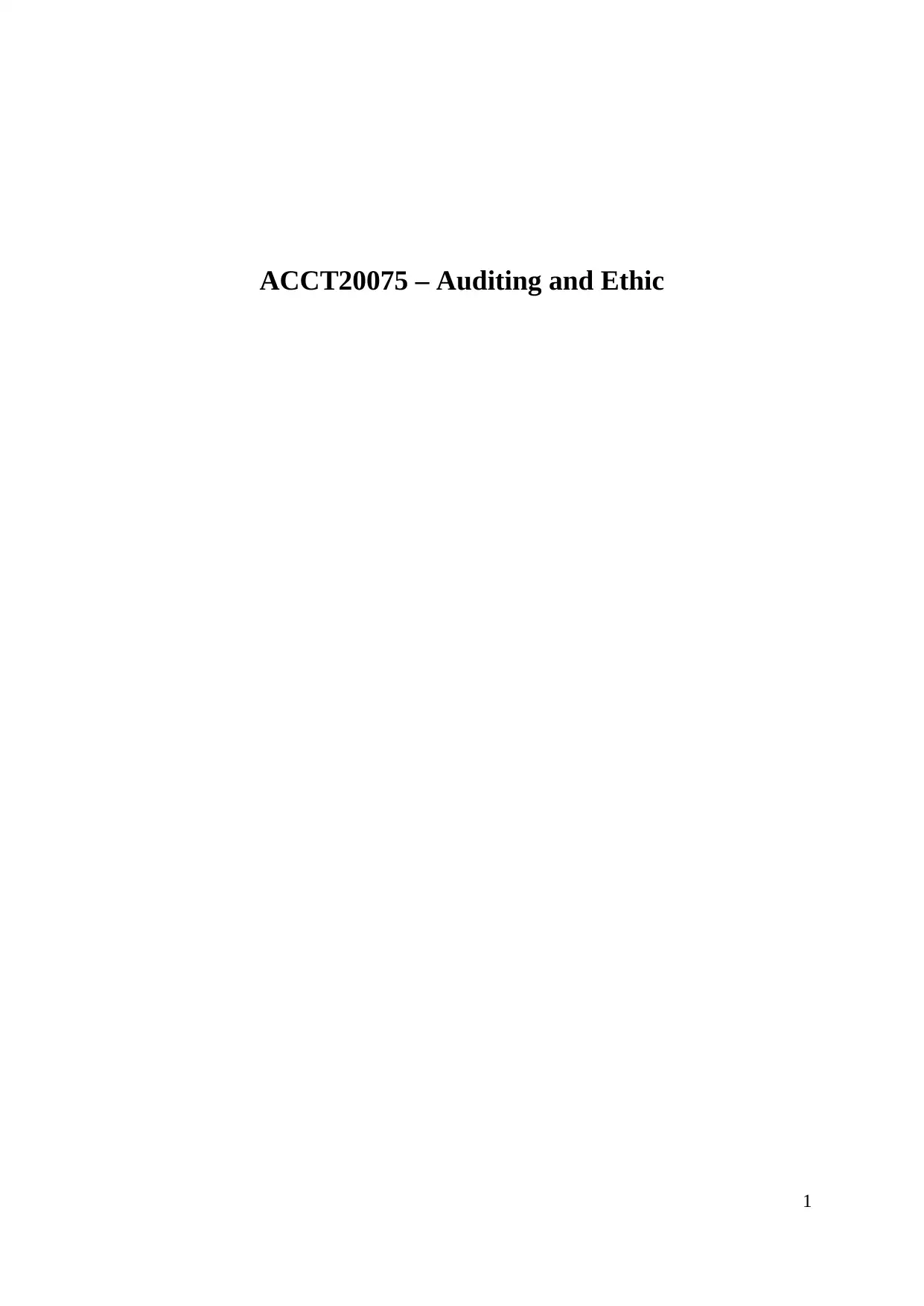
ACCT20075 – Auditing and Ethic
1
1
Paraphrase This Document
Need a fresh take? Get an instant paraphrase of this document with our AI Paraphraser
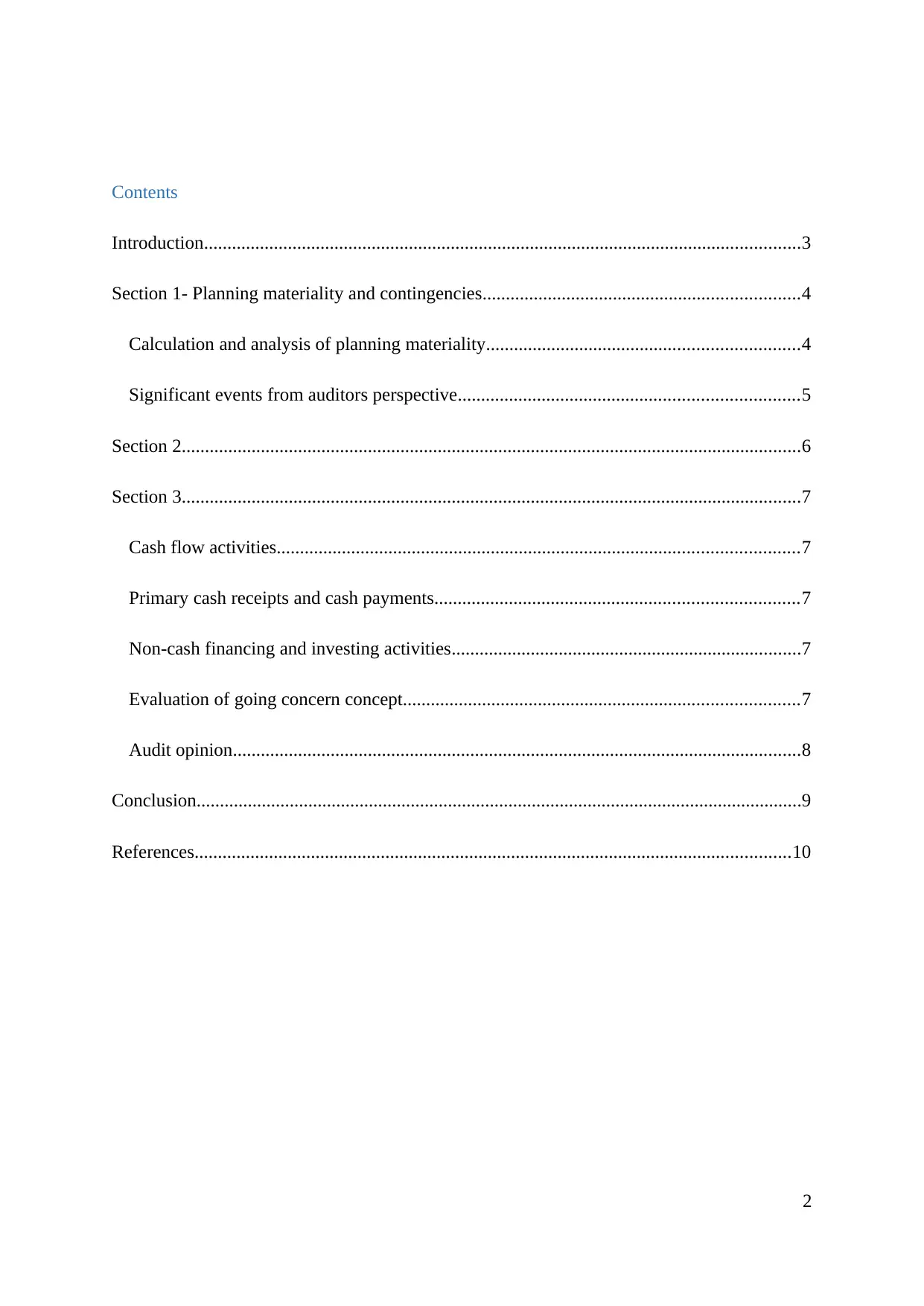
Contents
Introduction................................................................................................................................3
Section 1- Planning materiality and contingencies....................................................................4
Calculation and analysis of planning materiality...................................................................4
Significant events from auditors perspective.........................................................................5
Section 2.....................................................................................................................................6
Section 3.....................................................................................................................................7
Cash flow activities................................................................................................................7
Primary cash receipts and cash payments..............................................................................7
Non-cash financing and investing activities...........................................................................7
Evaluation of going concern concept.....................................................................................7
Audit opinion..........................................................................................................................8
Conclusion..................................................................................................................................9
References................................................................................................................................10
2
Introduction................................................................................................................................3
Section 1- Planning materiality and contingencies....................................................................4
Calculation and analysis of planning materiality...................................................................4
Significant events from auditors perspective.........................................................................5
Section 2.....................................................................................................................................6
Section 3.....................................................................................................................................7
Cash flow activities................................................................................................................7
Primary cash receipts and cash payments..............................................................................7
Non-cash financing and investing activities...........................................................................7
Evaluation of going concern concept.....................................................................................7
Audit opinion..........................................................................................................................8
Conclusion..................................................................................................................................9
References................................................................................................................................10
2
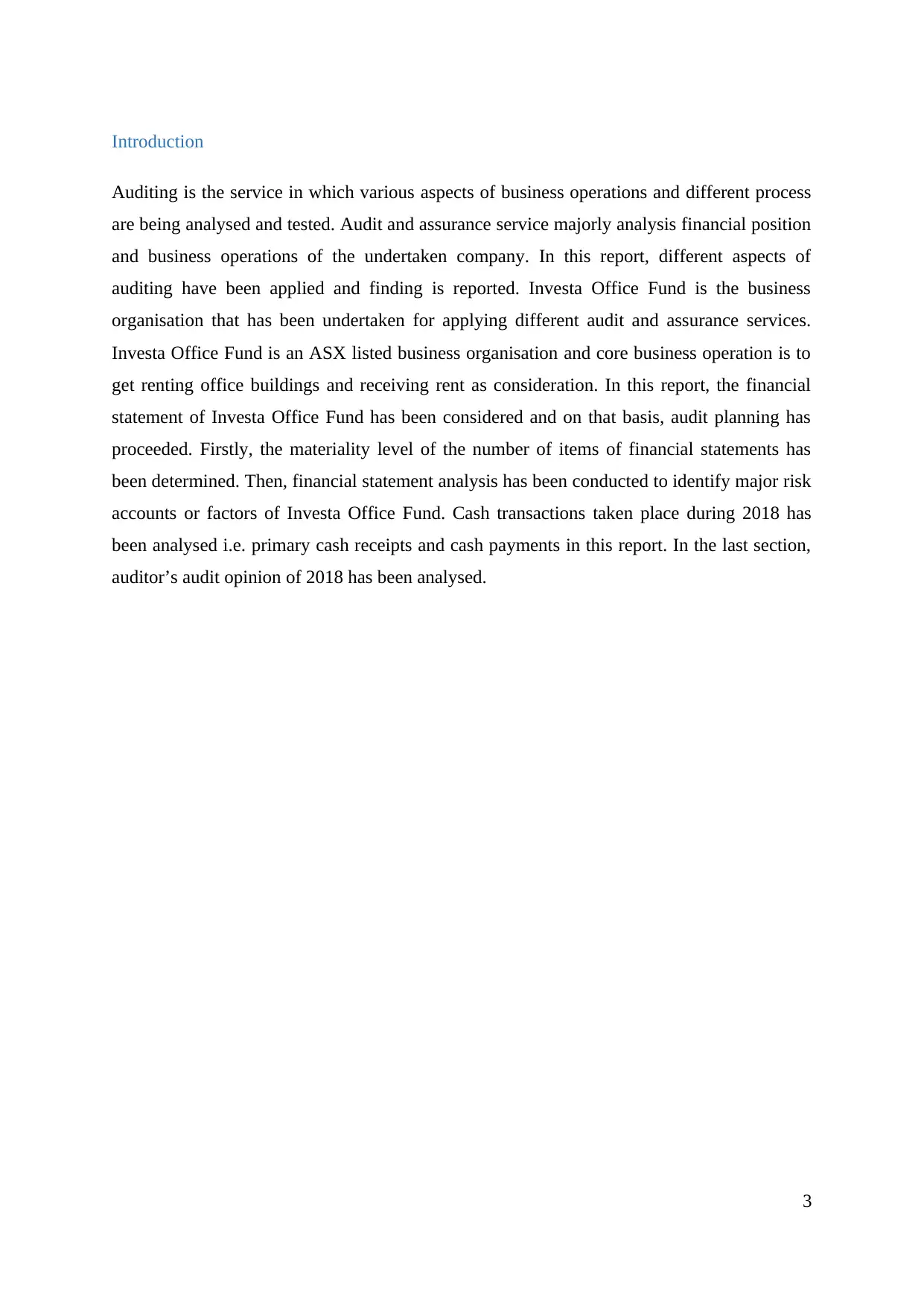
Introduction
Auditing is the service in which various aspects of business operations and different process
are being analysed and tested. Audit and assurance service majorly analysis financial position
and business operations of the undertaken company. In this report, different aspects of
auditing have been applied and finding is reported. Investa Office Fund is the business
organisation that has been undertaken for applying different audit and assurance services.
Investa Office Fund is an ASX listed business organisation and core business operation is to
get renting office buildings and receiving rent as consideration. In this report, the financial
statement of Investa Office Fund has been considered and on that basis, audit planning has
proceeded. Firstly, the materiality level of the number of items of financial statements has
been determined. Then, financial statement analysis has been conducted to identify major risk
accounts or factors of Investa Office Fund. Cash transactions taken place during 2018 has
been analysed i.e. primary cash receipts and cash payments in this report. In the last section,
auditor’s audit opinion of 2018 has been analysed.
3
Auditing is the service in which various aspects of business operations and different process
are being analysed and tested. Audit and assurance service majorly analysis financial position
and business operations of the undertaken company. In this report, different aspects of
auditing have been applied and finding is reported. Investa Office Fund is the business
organisation that has been undertaken for applying different audit and assurance services.
Investa Office Fund is an ASX listed business organisation and core business operation is to
get renting office buildings and receiving rent as consideration. In this report, the financial
statement of Investa Office Fund has been considered and on that basis, audit planning has
proceeded. Firstly, the materiality level of the number of items of financial statements has
been determined. Then, financial statement analysis has been conducted to identify major risk
accounts or factors of Investa Office Fund. Cash transactions taken place during 2018 has
been analysed i.e. primary cash receipts and cash payments in this report. In the last section,
auditor’s audit opinion of 2018 has been analysed.
3
⊘ This is a preview!⊘
Do you want full access?
Subscribe today to unlock all pages.

Trusted by 1+ million students worldwide
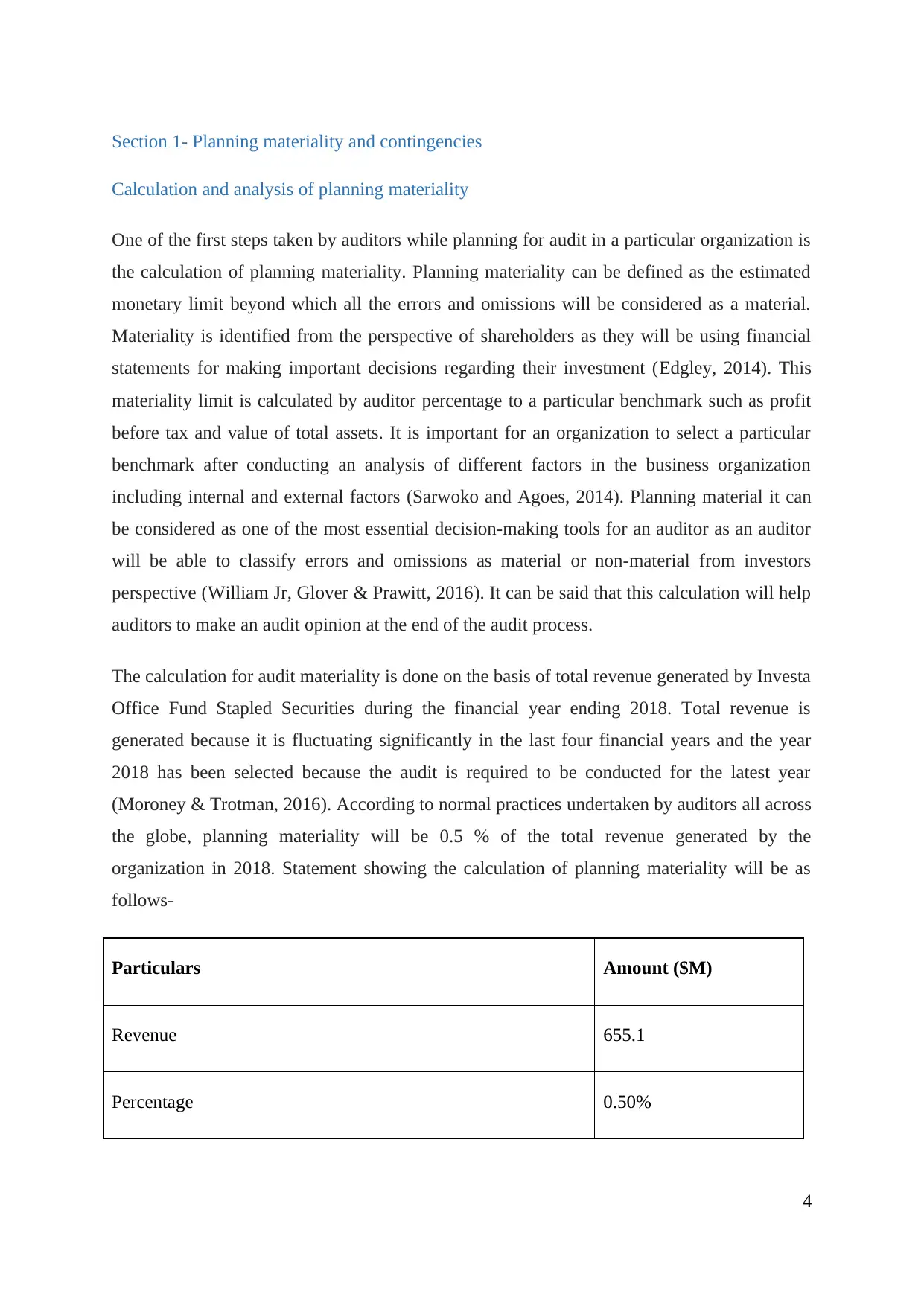
Section 1- Planning materiality and contingencies
Calculation and analysis of planning materiality
One of the first steps taken by auditors while planning for audit in a particular organization is
the calculation of planning materiality. Planning materiality can be defined as the estimated
monetary limit beyond which all the errors and omissions will be considered as a material.
Materiality is identified from the perspective of shareholders as they will be using financial
statements for making important decisions regarding their investment (Edgley, 2014). This
materiality limit is calculated by auditor percentage to a particular benchmark such as profit
before tax and value of total assets. It is important for an organization to select a particular
benchmark after conducting an analysis of different factors in the business organization
including internal and external factors (Sarwoko and Agoes, 2014). Planning material it can
be considered as one of the most essential decision-making tools for an auditor as an auditor
will be able to classify errors and omissions as material or non-material from investors
perspective (William Jr, Glover & Prawitt, 2016). It can be said that this calculation will help
auditors to make an audit opinion at the end of the audit process.
The calculation for audit materiality is done on the basis of total revenue generated by Investa
Office Fund Stapled Securities during the financial year ending 2018. Total revenue is
generated because it is fluctuating significantly in the last four financial years and the year
2018 has been selected because the audit is required to be conducted for the latest year
(Moroney & Trotman, 2016). According to normal practices undertaken by auditors all across
the globe, planning materiality will be 0.5 % of the total revenue generated by the
organization in 2018. Statement showing the calculation of planning materiality will be as
follows-
Particulars Amount ($M)
Revenue 655.1
Percentage 0.50%
4
Calculation and analysis of planning materiality
One of the first steps taken by auditors while planning for audit in a particular organization is
the calculation of planning materiality. Planning materiality can be defined as the estimated
monetary limit beyond which all the errors and omissions will be considered as a material.
Materiality is identified from the perspective of shareholders as they will be using financial
statements for making important decisions regarding their investment (Edgley, 2014). This
materiality limit is calculated by auditor percentage to a particular benchmark such as profit
before tax and value of total assets. It is important for an organization to select a particular
benchmark after conducting an analysis of different factors in the business organization
including internal and external factors (Sarwoko and Agoes, 2014). Planning material it can
be considered as one of the most essential decision-making tools for an auditor as an auditor
will be able to classify errors and omissions as material or non-material from investors
perspective (William Jr, Glover & Prawitt, 2016). It can be said that this calculation will help
auditors to make an audit opinion at the end of the audit process.
The calculation for audit materiality is done on the basis of total revenue generated by Investa
Office Fund Stapled Securities during the financial year ending 2018. Total revenue is
generated because it is fluctuating significantly in the last four financial years and the year
2018 has been selected because the audit is required to be conducted for the latest year
(Moroney & Trotman, 2016). According to normal practices undertaken by auditors all across
the globe, planning materiality will be 0.5 % of the total revenue generated by the
organization in 2018. Statement showing the calculation of planning materiality will be as
follows-
Particulars Amount ($M)
Revenue 655.1
Percentage 0.50%
4
Paraphrase This Document
Need a fresh take? Get an instant paraphrase of this document with our AI Paraphraser
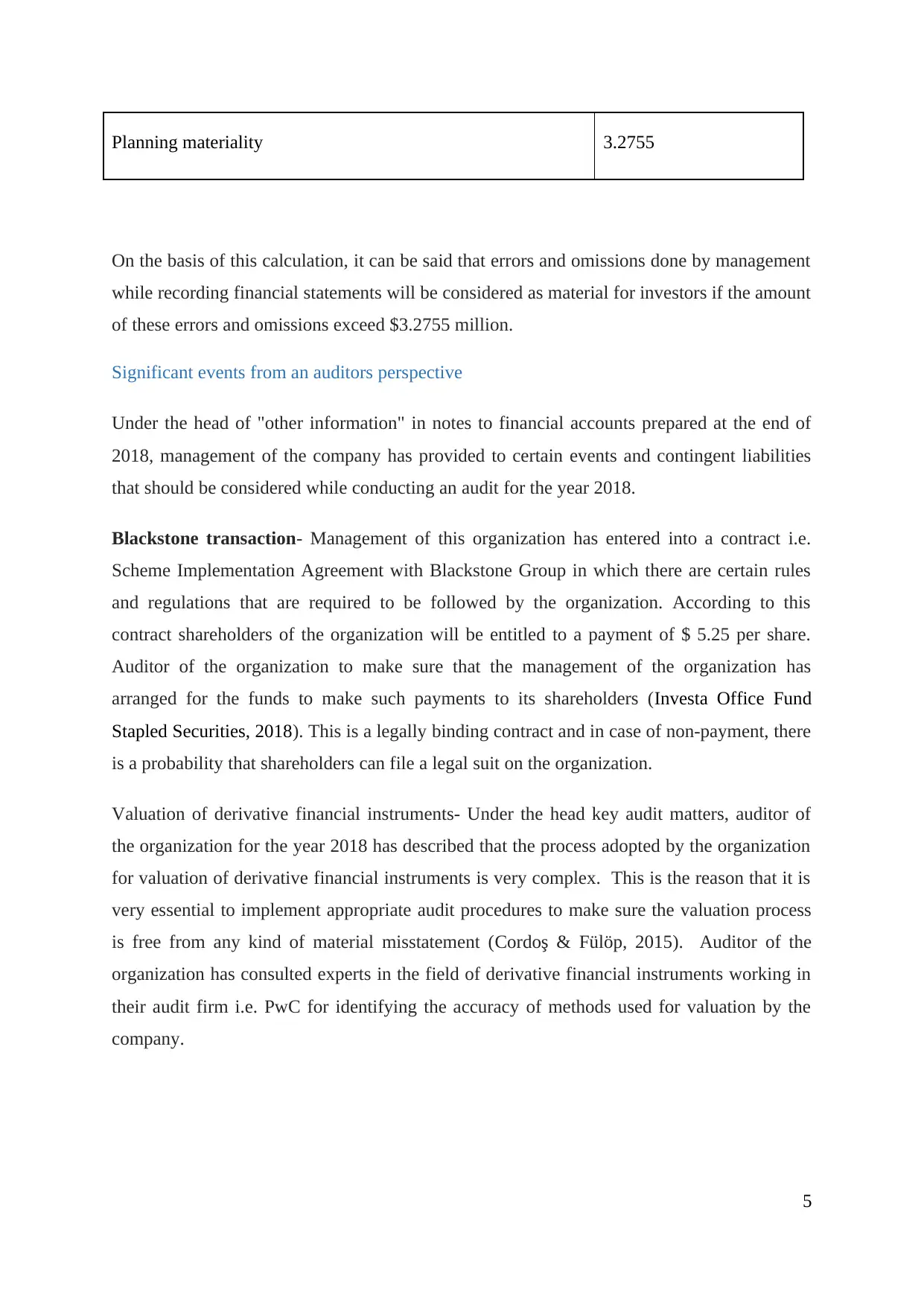
Planning materiality 3.2755
On the basis of this calculation, it can be said that errors and omissions done by management
while recording financial statements will be considered as material for investors if the amount
of these errors and omissions exceed $3.2755 million.
Significant events from an auditors perspective
Under the head of "other information" in notes to financial accounts prepared at the end of
2018, management of the company has provided to certain events and contingent liabilities
that should be considered while conducting an audit for the year 2018.
Blackstone transaction- Management of this organization has entered into a contract i.e.
Scheme Implementation Agreement with Blackstone Group in which there are certain rules
and regulations that are required to be followed by the organization. According to this
contract shareholders of the organization will be entitled to a payment of $ 5.25 per share.
Auditor of the organization to make sure that the management of the organization has
arranged for the funds to make such payments to its shareholders (Investa Office Fund
Stapled Securities, 2018). This is a legally binding contract and in case of non-payment, there
is a probability that shareholders can file a legal suit on the organization.
Valuation of derivative financial instruments- Under the head key audit matters, auditor of
the organization for the year 2018 has described that the process adopted by the organization
for valuation of derivative financial instruments is very complex. This is the reason that it is
very essential to implement appropriate audit procedures to make sure the valuation process
is free from any kind of material misstatement (Cordoş & Fülöp, 2015). Auditor of the
organization has consulted experts in the field of derivative financial instruments working in
their audit firm i.e. PwC for identifying the accuracy of methods used for valuation by the
company.
5
On the basis of this calculation, it can be said that errors and omissions done by management
while recording financial statements will be considered as material for investors if the amount
of these errors and omissions exceed $3.2755 million.
Significant events from an auditors perspective
Under the head of "other information" in notes to financial accounts prepared at the end of
2018, management of the company has provided to certain events and contingent liabilities
that should be considered while conducting an audit for the year 2018.
Blackstone transaction- Management of this organization has entered into a contract i.e.
Scheme Implementation Agreement with Blackstone Group in which there are certain rules
and regulations that are required to be followed by the organization. According to this
contract shareholders of the organization will be entitled to a payment of $ 5.25 per share.
Auditor of the organization to make sure that the management of the organization has
arranged for the funds to make such payments to its shareholders (Investa Office Fund
Stapled Securities, 2018). This is a legally binding contract and in case of non-payment, there
is a probability that shareholders can file a legal suit on the organization.
Valuation of derivative financial instruments- Under the head key audit matters, auditor of
the organization for the year 2018 has described that the process adopted by the organization
for valuation of derivative financial instruments is very complex. This is the reason that it is
very essential to implement appropriate audit procedures to make sure the valuation process
is free from any kind of material misstatement (Cordoş & Fülöp, 2015). Auditor of the
organization has consulted experts in the field of derivative financial instruments working in
their audit firm i.e. PwC for identifying the accuracy of methods used for valuation by the
company.
5

6
⊘ This is a preview!⊘
Do you want full access?
Subscribe today to unlock all pages.

Trusted by 1+ million students worldwide
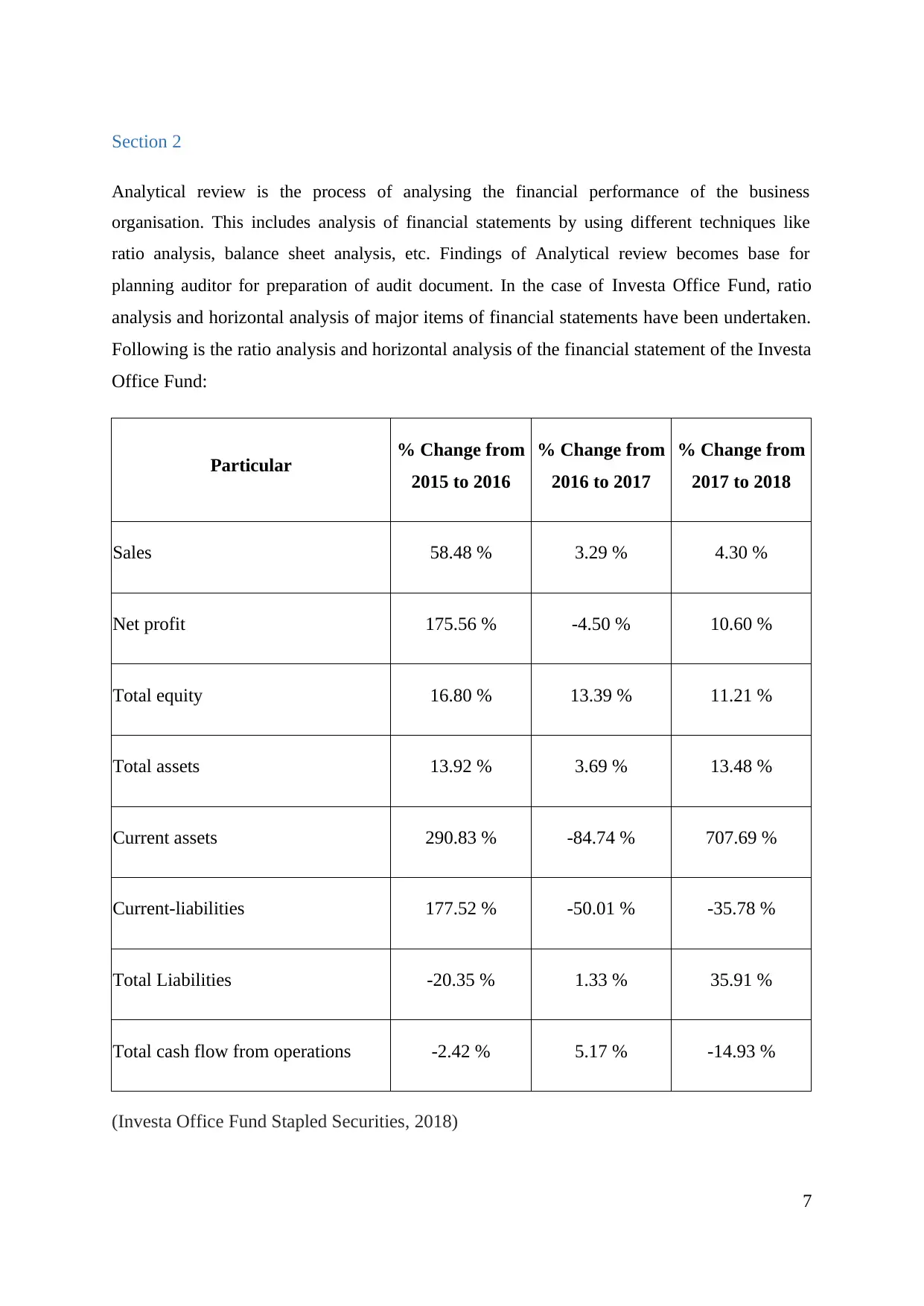
Section 2
Analytical review is the process of analysing the financial performance of the business
organisation. This includes analysis of financial statements by using different techniques like
ratio analysis, balance sheet analysis, etc. Findings of Analytical review becomes base for
planning auditor for preparation of audit document. In the case of Investa Office Fund, ratio
analysis and horizontal analysis of major items of financial statements have been undertaken.
Following is the ratio analysis and horizontal analysis of the financial statement of the Investa
Office Fund:
Particular % Change from
2015 to 2016
% Change from
2016 to 2017
% Change from
2017 to 2018
Sales 58.48 % 3.29 % 4.30 %
Net profit 175.56 % -4.50 % 10.60 %
Total equity 16.80 % 13.39 % 11.21 %
Total assets 13.92 % 3.69 % 13.48 %
Current assets 290.83 % -84.74 % 707.69 %
Current-liabilities 177.52 % -50.01 % -35.78 %
Total Liabilities -20.35 % 1.33 % 35.91 %
Total cash flow from operations -2.42 % 5.17 % -14.93 %
(Investa Office Fund Stapled Securities, 2018)
7
Analytical review is the process of analysing the financial performance of the business
organisation. This includes analysis of financial statements by using different techniques like
ratio analysis, balance sheet analysis, etc. Findings of Analytical review becomes base for
planning auditor for preparation of audit document. In the case of Investa Office Fund, ratio
analysis and horizontal analysis of major items of financial statements have been undertaken.
Following is the ratio analysis and horizontal analysis of the financial statement of the Investa
Office Fund:
Particular % Change from
2015 to 2016
% Change from
2016 to 2017
% Change from
2017 to 2018
Sales 58.48 % 3.29 % 4.30 %
Net profit 175.56 % -4.50 % 10.60 %
Total equity 16.80 % 13.39 % 11.21 %
Total assets 13.92 % 3.69 % 13.48 %
Current assets 290.83 % -84.74 % 707.69 %
Current-liabilities 177.52 % -50.01 % -35.78 %
Total Liabilities -20.35 % 1.33 % 35.91 %
Total cash flow from operations -2.42 % 5.17 % -14.93 %
(Investa Office Fund Stapled Securities, 2018)
7
Paraphrase This Document
Need a fresh take? Get an instant paraphrase of this document with our AI Paraphraser
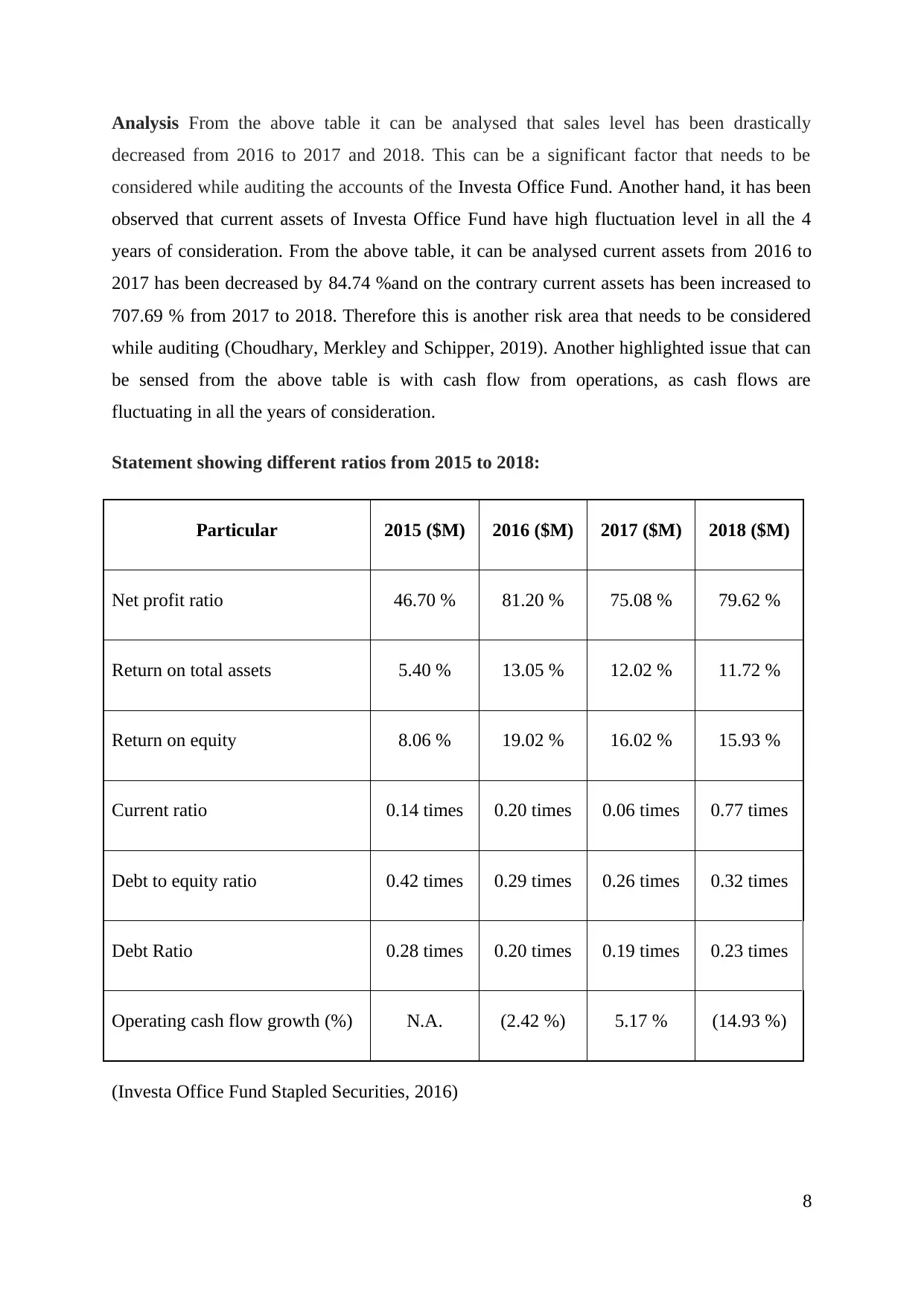
Analysis From the above table it can be analysed that sales level has been drastically
decreased from 2016 to 2017 and 2018. This can be a significant factor that needs to be
considered while auditing the accounts of the Investa Office Fund. Another hand, it has been
observed that current assets of Investa Office Fund have high fluctuation level in all the 4
years of consideration. From the above table, it can be analysed current assets from 2016 to
2017 has been decreased by 84.74 %and on the contrary current assets has been increased to
707.69 % from 2017 to 2018. Therefore this is another risk area that needs to be considered
while auditing (Choudhary, Merkley and Schipper, 2019). Another highlighted issue that can
be sensed from the above table is with cash flow from operations, as cash flows are
fluctuating in all the years of consideration.
Statement showing different ratios from 2015 to 2018:
Particular 2015 ($M) 2016 ($M) 2017 ($M) 2018 ($M)
Net profit ratio 46.70 % 81.20 % 75.08 % 79.62 %
Return on total assets 5.40 % 13.05 % 12.02 % 11.72 %
Return on equity 8.06 % 19.02 % 16.02 % 15.93 %
Current ratio 0.14 times 0.20 times 0.06 times 0.77 times
Debt to equity ratio 0.42 times 0.29 times 0.26 times 0.32 times
Debt Ratio 0.28 times 0.20 times 0.19 times 0.23 times
Operating cash flow growth (%) N.A. (2.42 %) 5.17 % (14.93 %)
(Investa Office Fund Stapled Securities, 2016)
8
decreased from 2016 to 2017 and 2018. This can be a significant factor that needs to be
considered while auditing the accounts of the Investa Office Fund. Another hand, it has been
observed that current assets of Investa Office Fund have high fluctuation level in all the 4
years of consideration. From the above table, it can be analysed current assets from 2016 to
2017 has been decreased by 84.74 %and on the contrary current assets has been increased to
707.69 % from 2017 to 2018. Therefore this is another risk area that needs to be considered
while auditing (Choudhary, Merkley and Schipper, 2019). Another highlighted issue that can
be sensed from the above table is with cash flow from operations, as cash flows are
fluctuating in all the years of consideration.
Statement showing different ratios from 2015 to 2018:
Particular 2015 ($M) 2016 ($M) 2017 ($M) 2018 ($M)
Net profit ratio 46.70 % 81.20 % 75.08 % 79.62 %
Return on total assets 5.40 % 13.05 % 12.02 % 11.72 %
Return on equity 8.06 % 19.02 % 16.02 % 15.93 %
Current ratio 0.14 times 0.20 times 0.06 times 0.77 times
Debt to equity ratio 0.42 times 0.29 times 0.26 times 0.32 times
Debt Ratio 0.28 times 0.20 times 0.19 times 0.23 times
Operating cash flow growth (%) N.A. (2.42 %) 5.17 % (14.93 %)
(Investa Office Fund Stapled Securities, 2016)
8
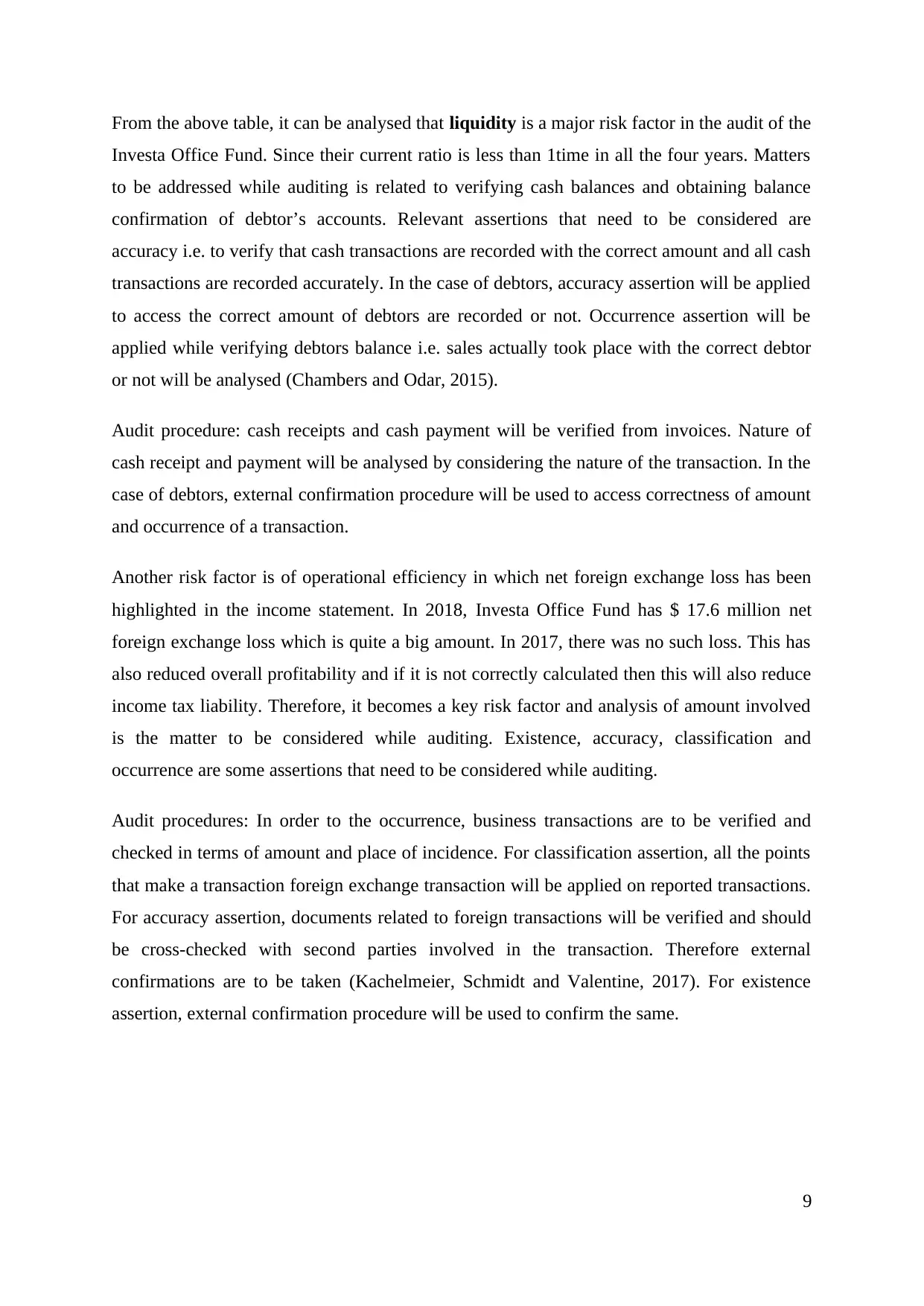
From the above table, it can be analysed that liquidity is a major risk factor in the audit of the
Investa Office Fund. Since their current ratio is less than 1time in all the four years. Matters
to be addressed while auditing is related to verifying cash balances and obtaining balance
confirmation of debtor’s accounts. Relevant assertions that need to be considered are
accuracy i.e. to verify that cash transactions are recorded with the correct amount and all cash
transactions are recorded accurately. In the case of debtors, accuracy assertion will be applied
to access the correct amount of debtors are recorded or not. Occurrence assertion will be
applied while verifying debtors balance i.e. sales actually took place with the correct debtor
or not will be analysed (Chambers and Odar, 2015).
Audit procedure: cash receipts and cash payment will be verified from invoices. Nature of
cash receipt and payment will be analysed by considering the nature of the transaction. In the
case of debtors, external confirmation procedure will be used to access correctness of amount
and occurrence of a transaction.
Another risk factor is of operational efficiency in which net foreign exchange loss has been
highlighted in the income statement. In 2018, Investa Office Fund has $ 17.6 million net
foreign exchange loss which is quite a big amount. In 2017, there was no such loss. This has
also reduced overall profitability and if it is not correctly calculated then this will also reduce
income tax liability. Therefore, it becomes a key risk factor and analysis of amount involved
is the matter to be considered while auditing. Existence, accuracy, classification and
occurrence are some assertions that need to be considered while auditing.
Audit procedures: In order to the occurrence, business transactions are to be verified and
checked in terms of amount and place of incidence. For classification assertion, all the points
that make a transaction foreign exchange transaction will be applied on reported transactions.
For accuracy assertion, documents related to foreign transactions will be verified and should
be cross-checked with second parties involved in the transaction. Therefore external
confirmations are to be taken (Kachelmeier, Schmidt and Valentine, 2017). For existence
assertion, external confirmation procedure will be used to confirm the same.
9
Investa Office Fund. Since their current ratio is less than 1time in all the four years. Matters
to be addressed while auditing is related to verifying cash balances and obtaining balance
confirmation of debtor’s accounts. Relevant assertions that need to be considered are
accuracy i.e. to verify that cash transactions are recorded with the correct amount and all cash
transactions are recorded accurately. In the case of debtors, accuracy assertion will be applied
to access the correct amount of debtors are recorded or not. Occurrence assertion will be
applied while verifying debtors balance i.e. sales actually took place with the correct debtor
or not will be analysed (Chambers and Odar, 2015).
Audit procedure: cash receipts and cash payment will be verified from invoices. Nature of
cash receipt and payment will be analysed by considering the nature of the transaction. In the
case of debtors, external confirmation procedure will be used to access correctness of amount
and occurrence of a transaction.
Another risk factor is of operational efficiency in which net foreign exchange loss has been
highlighted in the income statement. In 2018, Investa Office Fund has $ 17.6 million net
foreign exchange loss which is quite a big amount. In 2017, there was no such loss. This has
also reduced overall profitability and if it is not correctly calculated then this will also reduce
income tax liability. Therefore, it becomes a key risk factor and analysis of amount involved
is the matter to be considered while auditing. Existence, accuracy, classification and
occurrence are some assertions that need to be considered while auditing.
Audit procedures: In order to the occurrence, business transactions are to be verified and
checked in terms of amount and place of incidence. For classification assertion, all the points
that make a transaction foreign exchange transaction will be applied on reported transactions.
For accuracy assertion, documents related to foreign transactions will be verified and should
be cross-checked with second parties involved in the transaction. Therefore external
confirmations are to be taken (Kachelmeier, Schmidt and Valentine, 2017). For existence
assertion, external confirmation procedure will be used to confirm the same.
9
⊘ This is a preview!⊘
Do you want full access?
Subscribe today to unlock all pages.

Trusted by 1+ million students worldwide
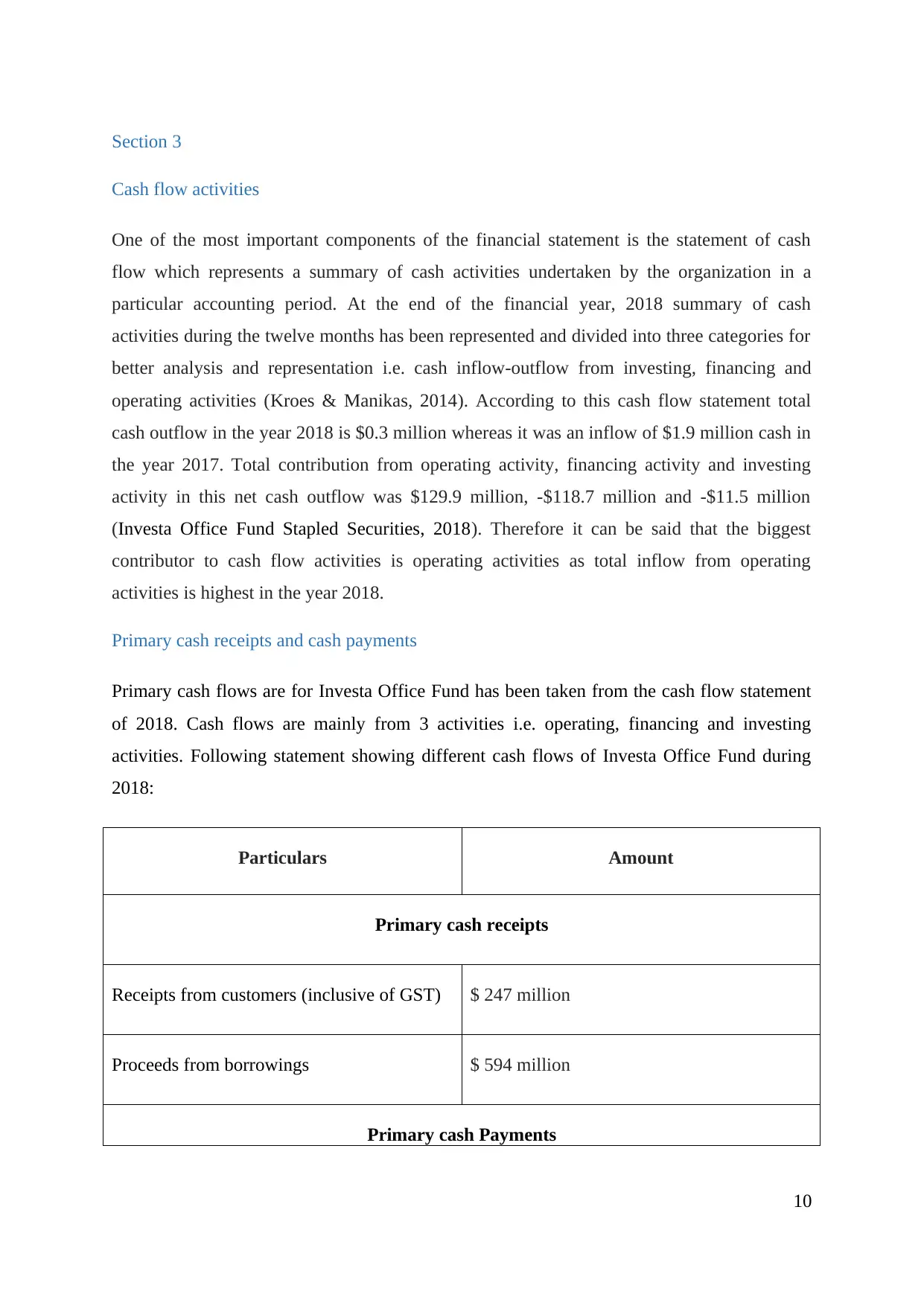
Section 3
Cash flow activities
One of the most important components of the financial statement is the statement of cash
flow which represents a summary of cash activities undertaken by the organization in a
particular accounting period. At the end of the financial year, 2018 summary of cash
activities during the twelve months has been represented and divided into three categories for
better analysis and representation i.e. cash inflow-outflow from investing, financing and
operating activities (Kroes & Manikas, 2014). According to this cash flow statement total
cash outflow in the year 2018 is $0.3 million whereas it was an inflow of $1.9 million cash in
the year 2017. Total contribution from operating activity, financing activity and investing
activity in this net cash outflow was $129.9 million, -$118.7 million and -$11.5 million
(Investa Office Fund Stapled Securities, 2018). Therefore it can be said that the biggest
contributor to cash flow activities is operating activities as total inflow from operating
activities is highest in the year 2018.
Primary cash receipts and cash payments
Primary cash flows are for Investa Office Fund has been taken from the cash flow statement
of 2018. Cash flows are mainly from 3 activities i.e. operating, financing and investing
activities. Following statement showing different cash flows of Investa Office Fund during
2018:
Particulars Amount
Primary cash receipts
Receipts from customers (inclusive of GST) $ 247 million
Proceeds from borrowings $ 594 million
Primary cash Payments
10
Cash flow activities
One of the most important components of the financial statement is the statement of cash
flow which represents a summary of cash activities undertaken by the organization in a
particular accounting period. At the end of the financial year, 2018 summary of cash
activities during the twelve months has been represented and divided into three categories for
better analysis and representation i.e. cash inflow-outflow from investing, financing and
operating activities (Kroes & Manikas, 2014). According to this cash flow statement total
cash outflow in the year 2018 is $0.3 million whereas it was an inflow of $1.9 million cash in
the year 2017. Total contribution from operating activity, financing activity and investing
activity in this net cash outflow was $129.9 million, -$118.7 million and -$11.5 million
(Investa Office Fund Stapled Securities, 2018). Therefore it can be said that the biggest
contributor to cash flow activities is operating activities as total inflow from operating
activities is highest in the year 2018.
Primary cash receipts and cash payments
Primary cash flows are for Investa Office Fund has been taken from the cash flow statement
of 2018. Cash flows are mainly from 3 activities i.e. operating, financing and investing
activities. Following statement showing different cash flows of Investa Office Fund during
2018:
Particulars Amount
Primary cash receipts
Receipts from customers (inclusive of GST) $ 247 million
Proceeds from borrowings $ 594 million
Primary cash Payments
10
Paraphrase This Document
Need a fresh take? Get an instant paraphrase of this document with our AI Paraphraser
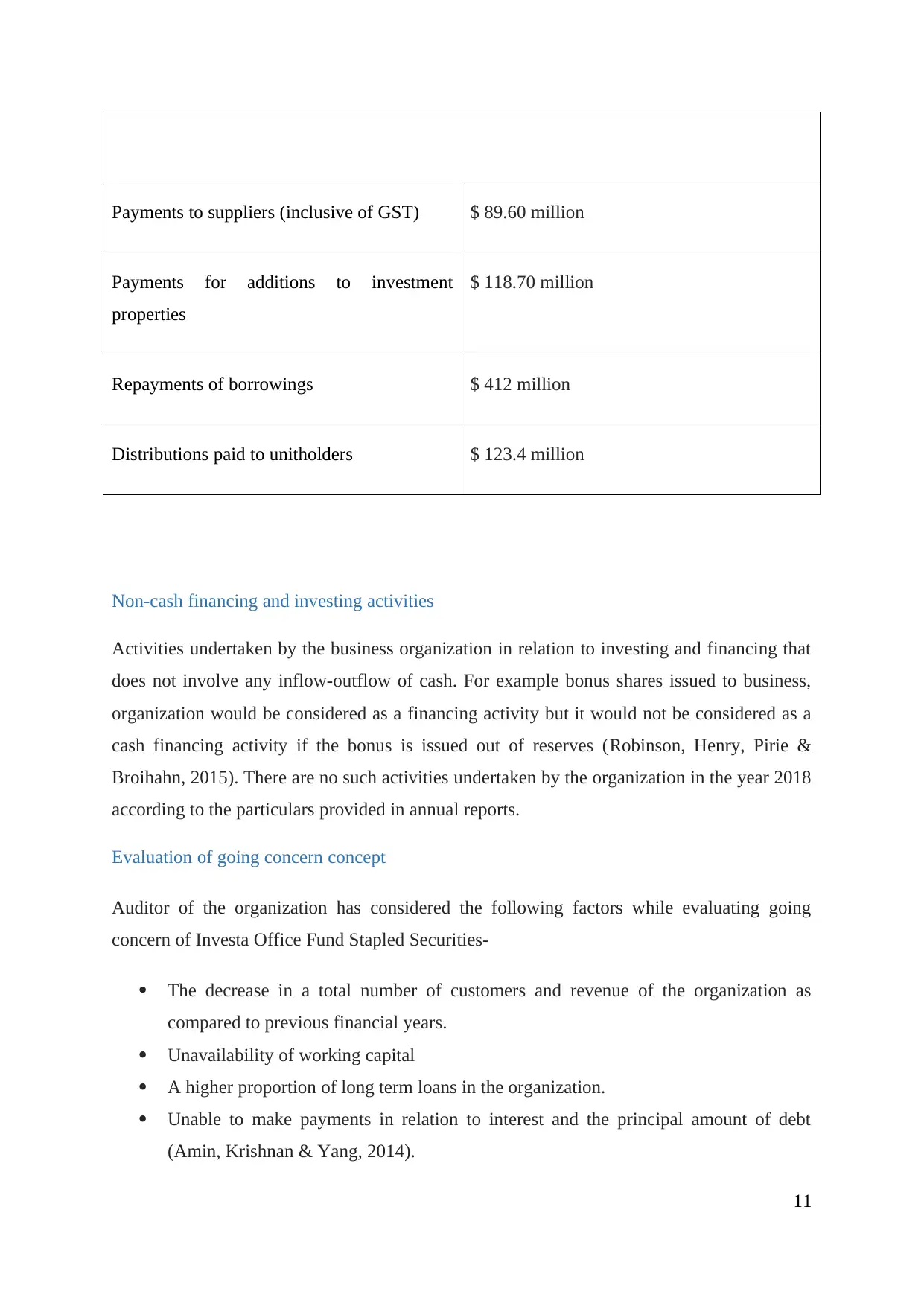
Payments to suppliers (inclusive of GST) $ 89.60 million
Payments for additions to investment
properties
$ 118.70 million
Repayments of borrowings $ 412 million
Distributions paid to unitholders $ 123.4 million
Non-cash financing and investing activities
Activities undertaken by the business organization in relation to investing and financing that
does not involve any inflow-outflow of cash. For example bonus shares issued to business,
organization would be considered as a financing activity but it would not be considered as a
cash financing activity if the bonus is issued out of reserves (Robinson, Henry, Pirie &
Broihahn, 2015). There are no such activities undertaken by the organization in the year 2018
according to the particulars provided in annual reports.
Evaluation of going concern concept
Auditor of the organization has considered the following factors while evaluating going
concern of Investa Office Fund Stapled Securities-
The decrease in a total number of customers and revenue of the organization as
compared to previous financial years.
Unavailability of working capital
A higher proportion of long term loans in the organization.
Unable to make payments in relation to interest and the principal amount of debt
(Amin, Krishnan & Yang, 2014).
11
Payments for additions to investment
properties
$ 118.70 million
Repayments of borrowings $ 412 million
Distributions paid to unitholders $ 123.4 million
Non-cash financing and investing activities
Activities undertaken by the business organization in relation to investing and financing that
does not involve any inflow-outflow of cash. For example bonus shares issued to business,
organization would be considered as a financing activity but it would not be considered as a
cash financing activity if the bonus is issued out of reserves (Robinson, Henry, Pirie &
Broihahn, 2015). There are no such activities undertaken by the organization in the year 2018
according to the particulars provided in annual reports.
Evaluation of going concern concept
Auditor of the organization has considered the following factors while evaluating going
concern of Investa Office Fund Stapled Securities-
The decrease in a total number of customers and revenue of the organization as
compared to previous financial years.
Unavailability of working capital
A higher proportion of long term loans in the organization.
Unable to make payments in relation to interest and the principal amount of debt
(Amin, Krishnan & Yang, 2014).
11
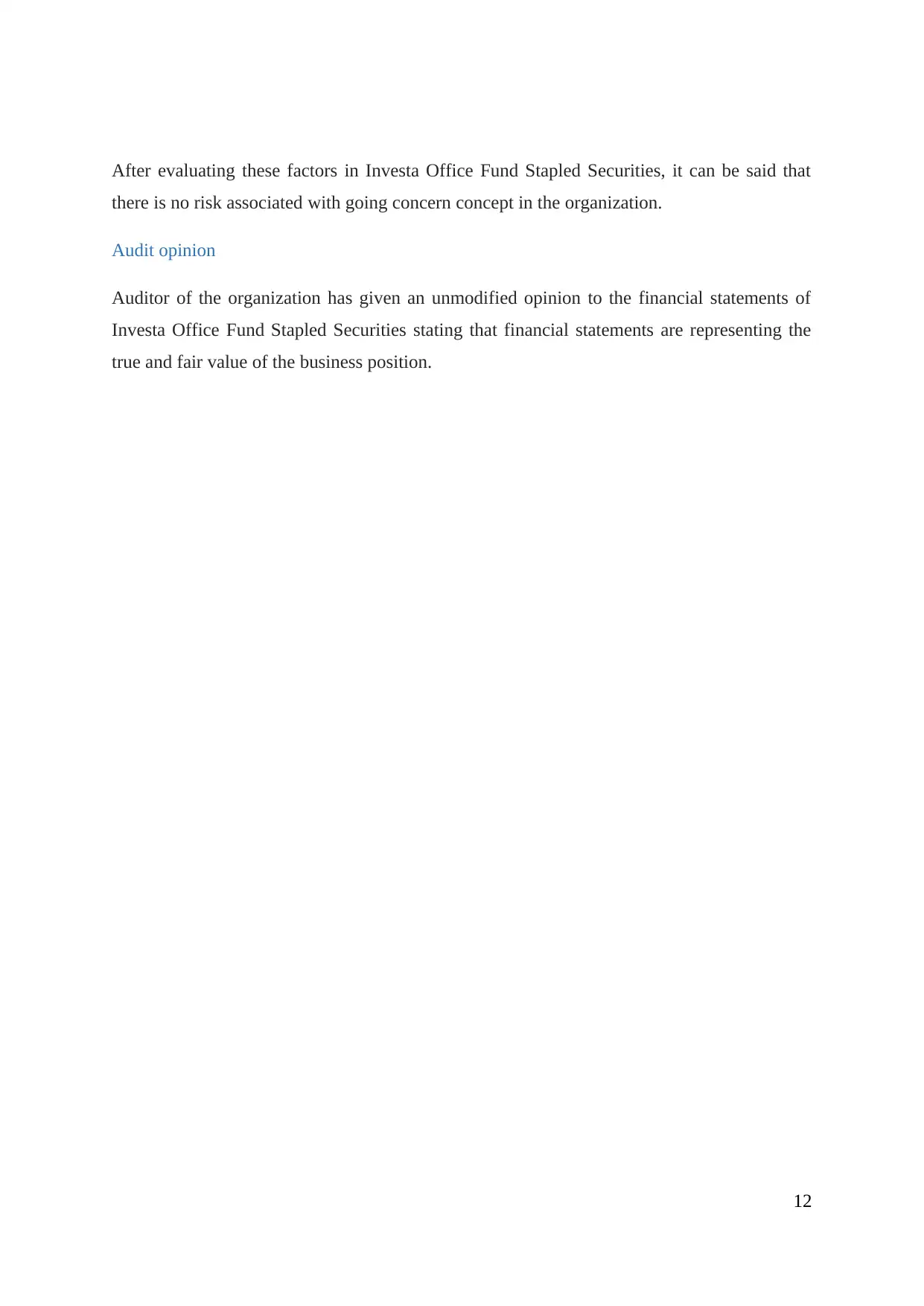
After evaluating these factors in Investa Office Fund Stapled Securities, it can be said that
there is no risk associated with going concern concept in the organization.
Audit opinion
Auditor of the organization has given an unmodified opinion to the financial statements of
Investa Office Fund Stapled Securities stating that financial statements are representing the
true and fair value of the business position.
12
there is no risk associated with going concern concept in the organization.
Audit opinion
Auditor of the organization has given an unmodified opinion to the financial statements of
Investa Office Fund Stapled Securities stating that financial statements are representing the
true and fair value of the business position.
12
⊘ This is a preview!⊘
Do you want full access?
Subscribe today to unlock all pages.

Trusted by 1+ million students worldwide

Conclusion
An overall conclusion it can be said that the planning process of audit is very essential to
make sure that there are no material misstatements in financial statements. This report has
conducted a ratio analysis for Investa Office Fund Stapled Securities to identify major
problems with the business operations. The main focus of this report was on conducting an
evaluation of auditor report issued by auditors on the financial year ending 2018. On the basis
of analysing audit report and annual report, it can be said that management has followed
every rule and regulation during the process of preparing financial statements.
13
An overall conclusion it can be said that the planning process of audit is very essential to
make sure that there are no material misstatements in financial statements. This report has
conducted a ratio analysis for Investa Office Fund Stapled Securities to identify major
problems with the business operations. The main focus of this report was on conducting an
evaluation of auditor report issued by auditors on the financial year ending 2018. On the basis
of analysing audit report and annual report, it can be said that management has followed
every rule and regulation during the process of preparing financial statements.
13
Paraphrase This Document
Need a fresh take? Get an instant paraphrase of this document with our AI Paraphraser

References
Amin, K., Krishnan, J., & Yang, J. S. (2014). Going concern opinion and cost of
equity. Auditing: A Journal of Practice & Theory, 33(4), 1-39.
Chambers, A. D., & Odar, M. (2015). A new vision for internal audit. Managerial Auditing
Journal, 30(1), 34-55.
Choudhary, P., Merkley, K. J., & Schipper, K. (2019). Auditors’ quantitative materiality
judgments: Properties and implications for financial reporting reliability. In 28th
Annual Conference on Financial Economics and Accounting.
Cordoş, G. S., & Fülöp, M. T. (2015). Understanding audit reporting changes: introduction
of Key Audit Matters. Accounting & Management Information Systems/Contabilitate
si Informatica de Gestiune, 14(1).
Edgley, C. (2014). A genealogy of accounting materiality. Critical Perspectives on
Accounting, 25(3), 255-271.
Investa Office Fund Stapled Securities. (2016). Annual report 2015-2016. Retrievable at:
https://www.investa.com.au/www_investa/media/resources/presentations/iof/iof-fy16-
annual-financial-report.pdf
Investa Office Fund Stapled Securities. (2018). Annual Report 2018. Retrievable at:
https://www.investa.com.au/funds/oipp/iof-archive/performance-periodic-statement/reports-
presentations
Kachelmeier, S. J., Schmidt, J. J., & Valentine, K. (2017). The disclaimer effect of disclosing
critical audit matters in the auditor’s report. Working paper.
Kroes, J. R., & Manikas, A. S. (2014). Cash flow management and manufacturing firm
financial performance: A longitudinal perspective. International Journal of Production
Economics, 148, 37-50.
14
Amin, K., Krishnan, J., & Yang, J. S. (2014). Going concern opinion and cost of
equity. Auditing: A Journal of Practice & Theory, 33(4), 1-39.
Chambers, A. D., & Odar, M. (2015). A new vision for internal audit. Managerial Auditing
Journal, 30(1), 34-55.
Choudhary, P., Merkley, K. J., & Schipper, K. (2019). Auditors’ quantitative materiality
judgments: Properties and implications for financial reporting reliability. In 28th
Annual Conference on Financial Economics and Accounting.
Cordoş, G. S., & Fülöp, M. T. (2015). Understanding audit reporting changes: introduction
of Key Audit Matters. Accounting & Management Information Systems/Contabilitate
si Informatica de Gestiune, 14(1).
Edgley, C. (2014). A genealogy of accounting materiality. Critical Perspectives on
Accounting, 25(3), 255-271.
Investa Office Fund Stapled Securities. (2016). Annual report 2015-2016. Retrievable at:
https://www.investa.com.au/www_investa/media/resources/presentations/iof/iof-fy16-
annual-financial-report.pdf
Investa Office Fund Stapled Securities. (2018). Annual Report 2018. Retrievable at:
https://www.investa.com.au/funds/oipp/iof-archive/performance-periodic-statement/reports-
presentations
Kachelmeier, S. J., Schmidt, J. J., & Valentine, K. (2017). The disclaimer effect of disclosing
critical audit matters in the auditor’s report. Working paper.
Kroes, J. R., & Manikas, A. S. (2014). Cash flow management and manufacturing firm
financial performance: A longitudinal perspective. International Journal of Production
Economics, 148, 37-50.
14
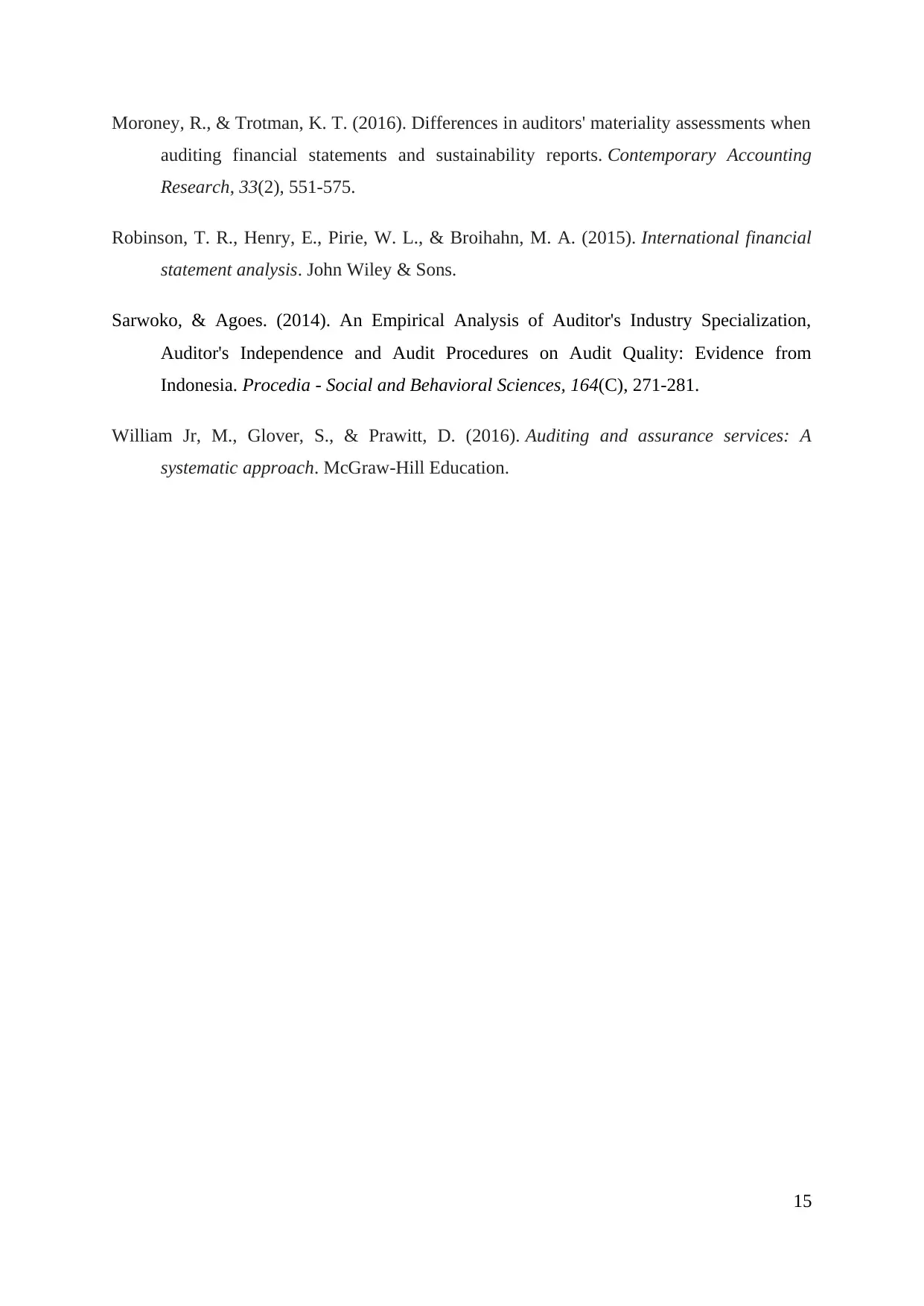
Moroney, R., & Trotman, K. T. (2016). Differences in auditors' materiality assessments when
auditing financial statements and sustainability reports. Contemporary Accounting
Research, 33(2), 551-575.
Robinson, T. R., Henry, E., Pirie, W. L., & Broihahn, M. A. (2015). International financial
statement analysis. John Wiley & Sons.
Sarwoko, & Agoes. (2014). An Empirical Analysis of Auditor's Industry Specialization,
Auditor's Independence and Audit Procedures on Audit Quality: Evidence from
Indonesia. Procedia - Social and Behavioral Sciences, 164(C), 271-281.
William Jr, M., Glover, S., & Prawitt, D. (2016). Auditing and assurance services: A
systematic approach. McGraw-Hill Education.
15
auditing financial statements and sustainability reports. Contemporary Accounting
Research, 33(2), 551-575.
Robinson, T. R., Henry, E., Pirie, W. L., & Broihahn, M. A. (2015). International financial
statement analysis. John Wiley & Sons.
Sarwoko, & Agoes. (2014). An Empirical Analysis of Auditor's Industry Specialization,
Auditor's Independence and Audit Procedures on Audit Quality: Evidence from
Indonesia. Procedia - Social and Behavioral Sciences, 164(C), 271-281.
William Jr, M., Glover, S., & Prawitt, D. (2016). Auditing and assurance services: A
systematic approach. McGraw-Hill Education.
15
⊘ This is a preview!⊘
Do you want full access?
Subscribe today to unlock all pages.

Trusted by 1+ million students worldwide
1 out of 15
Related Documents
Your All-in-One AI-Powered Toolkit for Academic Success.
+13062052269
info@desklib.com
Available 24*7 on WhatsApp / Email
![[object Object]](/_next/static/media/star-bottom.7253800d.svg)
Unlock your academic potential
© 2024 | Zucol Services PVT LTD | All rights reserved.





